Fancy a fantasy role-playing adventure but with guns? Instead of fighting dragons with sword and sorcery, it’s submachine guns and sorcery!
Tiny Tina’s Wonderlands is a standalone, first person loot-and-shoot game mixed with fantasy role-playing game (RPG) elements based on Borderlands gameplay mechanics.
It’s a similar concept to the 2013 Tiny Tina’s Assault on Dragon Keep, originally a Borderlands 2’s DLC and later a standalone game, but much bigger, more polished and more visually dazzling.
Since Wonderlands is part of the Borderlands franchise, there are plenty of similarities to Borderlands, but with some delightful fantasy twists.
For those who played Borderlands 2, you will recall that Tiny Tina is an orphan in the game who is a demolitions expert and is somewhat unstable.
In Wonderlands, Tiny Tina plays as the Dungeon Master of a Dungeon & Dragons-styled game known as Bunkers & Badasses (B&B), and conjures up a fantastical adventure with her whimsical, naïve and occasionally diabolical mind.
You play the Fatemaker as a character in Tiny Tina’s B&B game. Two other Non-Player Characters (NPCs), Valentine and Frette, also recurring characters from Borderlands, feature as other players of Tina’s B&B game. They offer plenty of lively commentary, comic relief and incessant chatter over the game. The annoying and somewhat endearing Claptrap also makes an appearance as a quest giver in B&B.
Tiny Tina’s Wonderlands also features Butt Stallion, a beautiful “binicorn”, which is a unicorn with two horns, and a Smiggle dream come true with all her sparkly rainbow coloured dazzles. Butt Stallion plays the queen of Brighthoof, which is the main town in the Wonderlands, and she needs a hero’s help to defeat the evil Dragon Lord.
But the star of the game is Tiny Tina herself. Yes, she can be irritating and overly dramatic sometimes, but seeing her struggle as a Dungeon Master against hard to please, smartass players and unforeseen changes to the script makes her very endearing.
Tiny Tina is voiced perfectly by the inimitable Ashly Burch (Aloy in Horizon Zero Dawn/Forbidden West), who is almost unrecognisable in Wonderlands with her high pitched, breathless and squeaky voice delivered with unbridled enthusiasm.
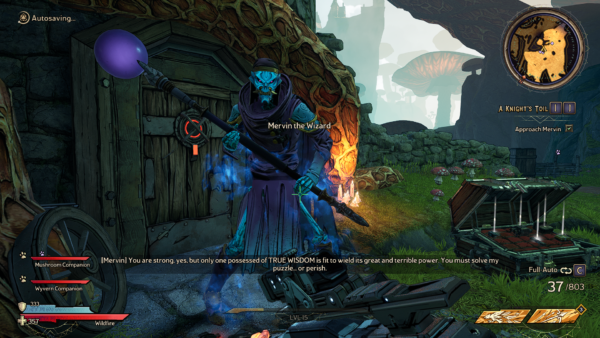
Class act
Like other Borderlands games, Wonderlands offers five different classes for your character to choose from when you start, each of which has great perks and drawbacks.
The skill trees for the character classes are well developed, and ensure good progression with careful investment of skill points, which are gained each time the Fatemaker levels up. It took me a long time and careful consideration of the skill tree to finally settle on one class!
There is the Brr-Zerker, who is a melee warrior with frost related damage and attributes; Graveborn, who is a spell user dealing dark magic damage boosted by sacrificing health and accompanied by a demi-lich companion; a Clawbringer who specialises in fire and lightning damage and accompanied by a Wyvern companion; a Spellshot who is a spell user with damage bonuses for using guns and spells; a Spore Warden who specialises in ranged and poison damage and accompanied by a mushroom companion, and a Stabbomancer who focuses on melee and evasion.
I definitely wanted a companion and preferred to deal damage from afar so I played a Spore Warden in my first playthrough, and I grew very attached to the adorable Mushroom Companion who can emit toxic farts under duress.
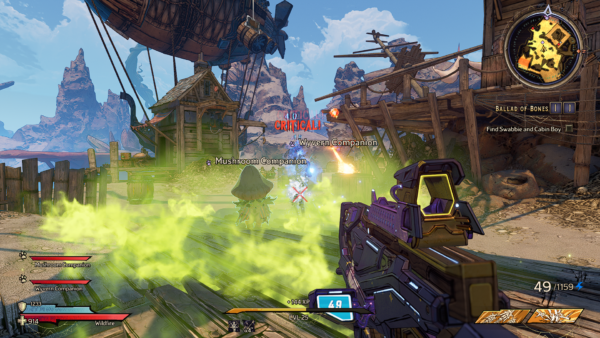
The main problem is that some of the enemies are also mushroomy types, so I have been accidentally attacking my poor buddy by mistake too often. Also, its toxic farts make things hard to see, so trying to shoot enemies in the dense green fog is difficult.
In addition, there is a secondary class for your character to take on when one of the main story quests has been completed. For that, I picked Claw Bringer to get another companion, this time a fire breathing wyvern. This made things a lot more exciting since now there are two skill trees to invest skill points on, and also compatibility of gear to consider.
With many different classes and abilities, as well as randomly generated loot, there is definitely some incentive to replay the game just to try out the other classes as well.
Weapons and wearables
The Borderlands franchise has one of the best loot systems in games, and Wonderlands continues this tradition. Attributes and rarity status of gear is randomly generated, so the variety of loot permutations is absolutely mind-blowing.
Serious loot lovers will happily spend loads of time comparing stats and testing out the properties of different weapons, wearables and equipment to deck out their characters.
Weapons in Wonderlands include a variety of swords for melee combat, and firearms including pistols, rifles and ballistic launchers. In addition, certain weapons can inflict elemental damage, such as poison, fire, frost, lightning and dark magic, which makes dealing damage to foes very enjoyable.
It’s also fun to see how certain weapons are reloaded by sprinkling with magic dust instead of the usual “lock and load” animations!
It’s almost impossible to run out of ammo in Wonderlands, since the game offers a generous amount of ammo in chests as well as gear that bestow ammo regeneration. Just like in Borderlands, you can also pay to increase ammo carrying capacity at the Blacksmith in Brighthoof.
As ammo capacity is limited by the weapon type, such as pistols, shotguns, assault rifles, sub machine guns, sniper rifles and heavy ballistic weapons, it makes sense to carry a variety of weapons on your adventures so you can switch to a different weapon class if a certain type of ammo runs out. Failing which, there are always spells, melee attacks and special class abilities that can deal significant hurt to enemies without needing ammo.
Wearables include amulets, rings and armour, which offers more abilities, buffs and attributes. With wearables granting a variety of buffs can help the Fatemaker be a good all-rounder no matter which class is picked, giving the game plenty of replayability. There are also spell books and wards that can be equipped to boost a whole variety of offensive and defensive abilities.
As with Borderlands, weapons and wearables produced by different manufacturers will have different attributes. For instance, weapons manufactured by Hyperius will deploy a shield when aiming down the sights, and Feriore weapons can be thrown at foes to deal a different type of attack, such as spawning a hydra head to aid in your fight. This makes experimenting with different types of weapons so much fun!
Although there is no lack of gold to collect, since all chests will regenerate continuously, upgrades at the Blacksmith can get very expensive in higher tiers, such as hundreds of thousands of gold to add three measly inventory slots in the Fatemaker’s backpack.
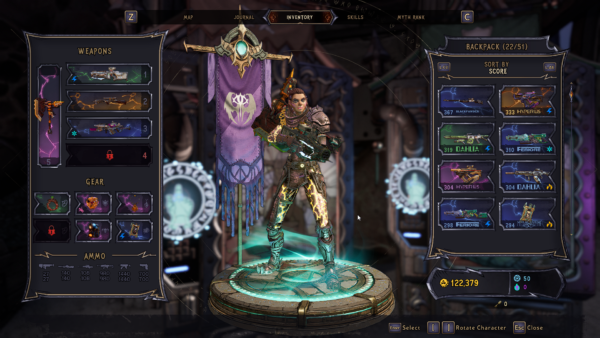
Gamers familiar with Borderlands will find the same system of loot classification in Wonderlands. Loot is classified as common (white), uncommon (green), rare (blue), epic (purple) and legendary (orange).
Like in Borderlands, loot can be sold and purchased in vending machines — The Mighty Knight for armour and shields, The Warsmith for guns and melee weapons, and Mystical Magicks for spellbooks, rings, and amulets.
A Lost Loot vending machine is also available in Brighthoof’s tavern if you are kiasu (the fear of losing out) and worry about missing out on rare loot. This is a great form of insurance, as rare loot that was not picked up will magically show up in the Lost Loot vending machine. Additional slots can be added at a price, which increases incrementally at each tier.
Hoarders and collectors will rejoice at the storage bank that can keep special items safe while you are off adventuring. Yes, I am guilty of hoarding Legendary level items that I don’t use just because they are so cool! Like the Lost Loot machine, the capacity of the storage bank can also be expanded by the Blacksmith at a price.
For those who love customising your character’s appearance, there’s also a booth available in the tavern for easy and instant customisation of your character’s appearance. This is where you can test out newly acquired cosmetic upgrades that are dropped by fallen foes. These include cosmetic enhancements like colours, armour effects, banners, as well as poses for the giant statue of you in Brighthoof. Talk about stroking one’s ego!
Never a dull moment
Tiny Tina’s Wonderlands offers many different areas that are well varied and fun to explore, such as the seabed, the tops of a beanstalk and a twisted mushroom forest.
All these areas are accessible in the Overland, where the Fatemaker has to walk on bottle cap bridges, through cheesy snack obstacles and past map pins, which are all part of Tiny Tina’s madcap design.
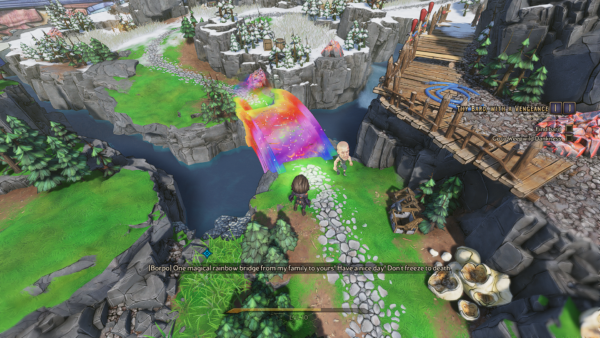
There’s also plenty to do in the Overland, with non-playing characters (NPCs) who bestow quests and rewards, dungeons to clear, random enemy encounters and collectibles to find. It’s worth taking time to find many collectibles that can improve stats and luck.
For instance, lucky dice that can be found in the Overland as well as various areas can increase loot luck, while shrine pieces that can be collected in various dungeons in the Overland will grant permanent buffs on the player, such as increased XP and gold gain, faster movement speed, as well as better stats.
Finding collectibles may require some puzzle solving as well as jumping puzzles, but there are risks of falling into a void or into water which causes death. Since the game’s jumping mechanism isn’t great, accidents happen and the Fatemaker will be resurrected at a price.
I applaud the game’s writers for taking cliches and adding their own twists to them, making the quests wildly imaginative, hilarious and enjoyable.
Examples of quests include helping a character named Ron Rivote, who suffers the same delusions as Don Quixote, fight windmills, settling a pirate feud turned bromance, and even helping a seemingly predictable villain who turns out to be a kind and helpful character in the end.
Additional quests also show up occasionally at noticeboards near the Brighthoof tavern, so there’s always loads of stuff for the Fatemaker to do.
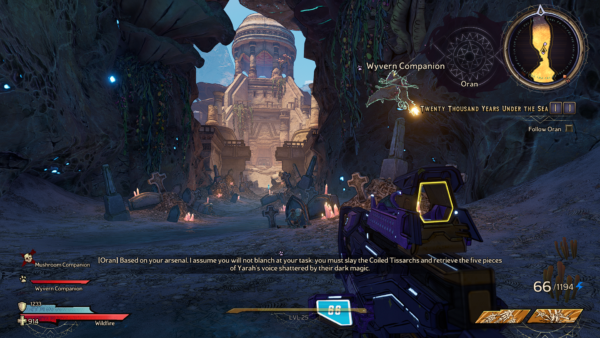
Although Wonderlands is a generous and forgiving game, with plenty of conveniences built for players, there are certain challenging bosses that can be a pain to beat. Having upgraded gear, weapons and companions can really turn the tide of the battle.
The other highlight of Wonderlands apart from the glorious loot, is being able to shoot fantasy foes with guns. It’s somehow very satisfying to shoot fire-breathing wyverns with rifles, shred skeletons with submachine guns, blow away goblins with shotguns and blast trolls with rocket launchers.
Health potions for instant use are also readily available in chests, and certain perks and gear also offer health regeneration, so one can usually find a way to survive even in tricky situations.
If you lose all your health, the game gives you a chance to be revived if you manage to kill something before the timer runs out via a “Death Save”. Or, if you play a Spore Warden, the Mushroom companion has a perk that lets it resurrect the Fatemaker.
In the worst case, you cannot be revived in time and you will restart at the last save point with some gold deducted as a penalty, while all the foes you had beaten previously will respawn with full health.
There’s never a dull or lonely moment as you explore the Wonderlands — it’s definitely a light-hearted and humorous “feel good” game. Well, at least most of the time, since there is a good dose of death and destruction and some cataclysmic, earth-shattering events as well, but that’s dealt with in a cavalier manner.
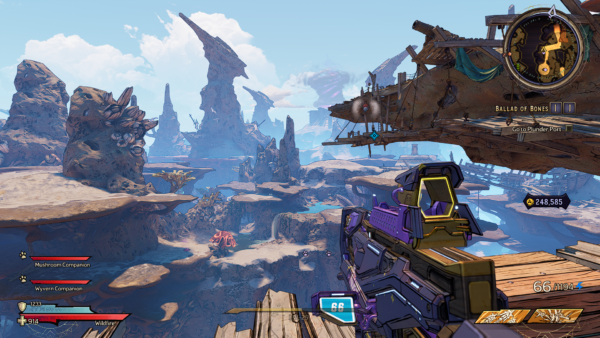
Look who’s talking?
Tiny Tina’s Wonderlands feature plenty of witty and amusing dialogue, including some crude humour and not safe for work (NSFW) references that are censored half-heartedly.
Unfortunately, I found it hard to follow most of the dialogue due to overlapping conversations and monologues by NPCs, constant bickering between Valentine and Frette outside the B&B game as well as by Tina herself, mixed with the screaming from enemies, chatter from characters in the game, and even wisecracks from the player character.
All these make for a pretty messy audio experience, and even with the subtitles turned on, I couldn’t keep up with so much happening at the same time.
Add that to the constant barrage of noise from frenetic action in combat, sound effects from the companions and the environment, and I get overwhelmed by the clamorous soundstage during heated battles.
Even after the battles are done, I am usually distracted by gathering, assessing or dumping loot, and miss most of what was being said. There are very few cutscenes to move the narrative forward, so it’s difficult to focus while being constantly distracted by loot while someone is talking.

In terms of graphics, Wonderlands runs well enough for me to smoothly blast enemies into oblivion on my three-year-old PC with a dated AMD Radeon RX 590 graphics card.
I noticed some noticeable slowdowns during major explosive effects and low resolution textures loading when I entered a new area, but this does not take away from the beauty of the detailed maps and imaginative landscapes as well as fun battles.
Even though Wonderlands still uses the distinctive cel-shading effects of the Borderlands franchise, the weapons and spell effects and animations are more sophisticated, making the game look great, although it can get visually overwhelming during heated battles.
Tiny Tina’s Wonderlands offer a crossplay multiplayer co-op mode where your friends on any platform can join the game and play with you.
Similar to Borderlands’ multiplayer mechanics, you can choose to play Cooperation or Coopetition (sic) modes, the former being a more harmonious mode where gear and enemies are scaled to individual players, while the latter mode means players snatching the same loot drops and enemies are scaled to the level of the host player, which can be tough for lower-level players.
TL;DR
For a cleverly scripted, lighthearted and whimsical fantasy RPG with guns, Tiny Tina’s Wonderlands scores with its witty dialogue, amusing characters and hilarious quests, and wildly imaginative places to explore and glorious loot to collect. However, the clamorous soundstage, incessant overlapping dialogue and frenetic activity makes it hard to focus.
Its highly rewarding gameplay and generous convenience features guarantee plenty of endorphins while playing. Some jumping puzzles can be challenging but are usually optional, so unless you are a diehard completist, you can happily let them go.
With violence, death, crude humour and suggestive themes, the game is better suited for teens and older gamers, as recommended by ESRB. As for the “partial nudity”, unless you are offended by mushroom butts, I wouldn’t worry too much about it being a bad influence for the young.
Tiny Tina’s Wonderlands is available for the Xbox, PlayStation, and PC for S$84.90 for the base game. The PC version is exclusive in the Epic Games Store, and will be available much later on Steam, with the DLCs costing a separate S$13.90 each. The Season Pass with all DLCs is priced at S$39.90.
If you are willing to splurge, you can get the Chaotic Great Edition at S$109 for the base game plus the Season Pass.






